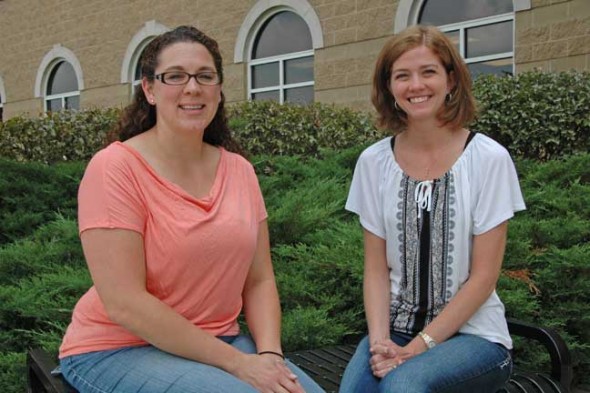
New to Mills Lawn this year are fourth-grade teacher Cheryl Devine, left, and fifth and sixth grade special education teacher Renée Hatert. The two joined other district teachers this week for several days of professional development at AU Midwest before school starts Friday. (photo by Lauren Heaton)
Mills Lawn on the move to innovate
- Published: August 28, 2014
When Mills Lawn School opens its doors this Friday, it will serve more students than last year, a growth trend that Principal Matt Housh sees as steady.
“Every year we continue to grow, but we grow in different ways,” Housh said in an interview last week.
While last year a surge in 5- and 6-year-olds led to the school offering a third kindergarten class, this year the school cut back to two kindergartens but added a third fourth-grade room to accommodate higher numbers of older children. All together, the school will open with 376 students, 20 more than it had six years ago.
This year, Mills Lawn has three first-, second-, fourth- and fifth-grade rooms and two kindergartens, third- and sixth-grade classes. And the class sizes, which average about 21 students per room, are neither too small nor too large, Housh said, stating that many elementary schools have 26 or 27 students per room.
“We’re maintaining a healthy class size without getting too big,” he said.
Several factors have led to the school’s growth, Housh believes, starting with more people moving to Yellow Springs.
“We have new families in town,” he said.
And a second factor is a robust number of open enrollment students who fill up any gaps in classroom size — this year, the school will have 84 children from Xenia, Clifton, Springfield, Beavercreek and as far away as Huber Heights, where Housh worked as principal before coming to Yellow Springs five years ago.
Housh links the healthy open enrollment numbers to the school district’s growing reputation for child-centered education.
“People know we’re on the move, doing innovative things,” Housh said.
The main source of that innovation, the school district’s embrace of project-based learning, or PBL, will continue this year as the school’s primary focus. While last year teachers and administrators worked hard to incorporate PBL in their classrooms, this year’s focus will be on finding how, exactly, to give the new teaching strategy a distinctively Yellow Springs flavor.
“This year, we’re establishing what our vision is,” Housh said. “Now we need to say, what is PBL in Yellow Springs, how are we unique?”
Mills Lawn teachers are spending professional days this week building a vision, and will continue the effort throughout the year, with newly established early morning professional time on 14 Wednesdays throughout the year, according to Housh.
Project-based learning is a student-centered, collaborative, hands-on approach in which the teacher becomes more a facilitator and less a director of the learning process, according to Housh. Students in PBL have more “voice and choice” in their learning, with their preferences driving the choice of project. The strategy aims at empowering children to see “that they have the potential to make things better,” Housh said. “This appeals to kids. They want to do important things.”
In its launch last school year, PBL projects included second graders studying the threat of emerald ash borers, producing booklets that identified species of trees on the MLS grounds, and recommending which ash trees should be cut down and which ones saved, recommendations that the school district will mostly follow, according to Housh. First graders studied flowers and weeds in a project that culminated in the redesign of school flower beds, while third graders interviewed villagers in a wide variety of jobs, also creating digital recordings of the interviews.
The new approach to learning, which grew from the district’s 2020 Plan, seemed to fire up both teachers and students, Housh said. In his own home, his first-grader and fourth-grader last year talked more about what happened in school than they had previously, a trend he said other parents also reported.
“I saw a bubbling excitement and engagement on a level that I hadn’t seen before,” he said. “You could feel the buzz.”
But the project’s first year also had its share of challenges, and some teachers adapted to the new teaching strategy more easily than others. So this year the school district will focus on enhancing support for PBL, empowering teachers who exhibited “a high level of PBL ability and leadership” to take on the responsibility to help others adapt to the new system. Mills Lawn teachers Heidi Hoover and Sarah Amin will be the school’s PBL coaches, while three other teachers will assume the coaching role in the middle school and high school.
“These teachers are already known and trusted inside the building,” Housh said of the new PBL coaching system. “I think this is huge.”
The school will also continue its effort to find effective ways to assess student outcomes, Housh said.
Mills Lawn this year also hopes to strengthen its effort to improve school climate. Last year’s “Project Peace” effort will continue, and in 2014–15 the school will partner with local nonprofits, such as YS Kids Playhouse, to help kids become more familiar with peace-making behavior, including through role-playing and performance.
“They have the conceptual understanding” of positive behaviors, Housh said. “Now it’s about the practice.”
New this year at Mills Lawn will be two teachers. Heading the third fourth-grade class is Cheryl Devine, a veteran teacher from Colorado who rose to the top of about 150 applicants for the position. Devine comes from an International Baccalaureate school, which focuses on interdisciplinary education, a background that Housh believes will contribute to the Mills Lawn PBL emphasis.
Also new is special education teacher Renée Hatert of Cedarville, who Housh describes as “very effective and having a great rapport with kids.” About 70 to 80 applicants applied for the special ed job.
“We had a great pool of applicants, very strong,” he said.
Also new to the school is a fresh crop of Chromebooks, which are cheaper and more lightweight than laptops but provide many of the same capabilities. The school now has a ratio of two students to each Chromebook for fourth through sixth graders, and the equipment will be used by students working together on research projects.
The 2014–2015 school year will not skimp on challenges for Mills Lawn teachers and staff, and an increase in state-mandated testing for grades three through eight heads the list. While the school district earlier this summer announced that it might get a waiver for state testing due to its inclusion in a group of 15 innovative school districts, Yellow Springs recently learned that at least this year, the schools must continue to test.
But while Mills Lawn will do what it must to comply with state law, Housh has no intention of diminishing the school’s emphasis on project-based learning.
“I’m empowering my teachers to do PBL, to be adventurous, to take risks,” he said. Tests should be treated as tests, not curriculum, he said, stating that, regarding the state tests, “I’m firmly convinced that these tests don’t measure the important things.”
Those important things are whether students are learning to communicate, to think critically, to have grit and to find creative solutions to problems, according to Housh, and that’s what he believes project-based learning teaches.
“I’m very excited about this year,” he said. “We have a great team and we’re doing the right things.”
The Yellow Springs News encourages respectful discussion of this article.
You must login to post a comment.
Don't have a login? Register for a free YSNews.com account.

Parkinsons.jpg)













No comments yet for this article.